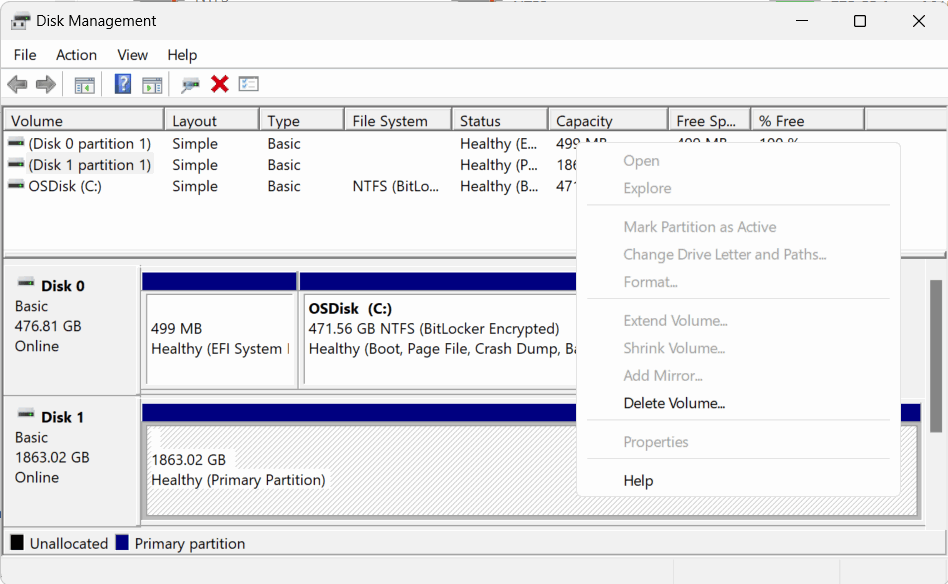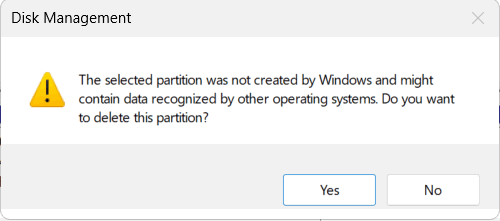When partitioning a SATA hard drive in Linux and formatting it with mkfs.ntfs, the files cannot be read when connected to Windows. By using Win+x to open Disk Manager, the hard drive is recognized (Disk1), but no drive letter is assigned:
The context menu options are mostly greyed out, with only Delete Volume available. However, selecting this option will issue a warning, indicating that the partition was not created by Windows and that deleting it will erase the data:
To resolve this issue, it was found that when partitioning with fdisk in Linux, the default partition type is set to Linux, which is likely the reason Windows cannot recognize it:
$ fdisk /dev/sdd
Command (m for help): p
Disk /dev/sdd: 1.82 TiB, 2000398934016 bytes, 3907029168 sectors
Disk model: EZBX-60AYRA0
Units: sectors of 1 * 512 = 512 bytes
Sector size (logical/physical): 512 bytes / 512 bytes
I/O size (minimum/optimal): 512 bytes / 512 bytes
Disklabel type: dos
Disk identifier: 0xdd1eb4e4
Device Boot Start End Sectors Size Id Type
/dev/sdd1 2048 3907029167 3907027120 1.8T 83 Linux
Using the fdisk command t to change the type to NTFS (07):
Command (m for help): t
Selected partition 1
Hex code or alias (type L to list all): L
00 Empty 24 NEC DOS 81 Minix / old Lin bf Solaris
01 FAT12 27 Hidden NTFS Win 82 Linux swap / So c1 DRDOS/sec (FAT-02 XENIX root 39 Plan 9 83 Linux c4 DRDOS/sec (FAT-03 XENIX usr 3c PartitionMagic 84 OS/2 hidden or c6 DRDOS/sec (FAT-04 FAT16 <32M 40 Venix 80286 85 Linux extended c7 Syrinx
05 Extended 41 PPC PReP Boot 86 NTFS volume set da Non-FS data
06 FAT16 42 SFS 87 NTFS volume set db CP/M / CTOS / .
07 HPFS/NTFS/exFAT 4d QNX4.x 88 Linux plaintext de Dell Utility
08 AIX 4e QNX4.x 2nd part 8e Linux LVM df BootIt
09 AIX bootable 4f QNX4.x 3rd part 93 Amoeba e1 DOS access
0a OS/2 Boot Manag 50 OnTrack DM 94 Amoeba BBT e3 DOS R/O
0b W95 FAT32 51 OnTrack DM6 Aux 9f BSD/OS e4 SpeedStor
0c W95 FAT32 (LBA) 52 CP/M a0 IBM Thinkpad hi ea Linux extended
0e W95 FAT16 (LBA) 53 OnTrack DM6 Aux a5 FreeBSD eb BeOS fs
0f W95 Ext'd (LBA) 54 OnTrackDM6 a6 OpenBSD ee GPT
10 OPUS 55 EZ-Drive a7 NeXTSTEP ef EFI (FAT-12/16/11 Hidden FAT12 56 Golden Bow a8 Darwin UFS f0 Linux/PA-RISC
b12 Compaq diagnost 5c Priam Edisk a9 NetBSD f1 SpeedStor
14 Hidden FAT16 <3 61 SpeedStor ab Darwin boot f4 SpeedStor
16 Hidden FAT16 63 GNU HURD or Sys af HFS / HFS+ f2 DOS secondary
17 Hidden HPFS/NTF 64 Novell Netware b7 BSDI fs fb VMware VMFS
18 AST SmartSleep 65 Novell Netware b8 BSDI swap fc VMware VMKCORE
1b Hidden W95 FAT3 70 DiskSecure Mult bb Boot Wizard hid
fd Linux raid auto
1c Hidden W95 FAT3 75 PC/IX bc Acronis FAT32 L fe LANstep
1e Hidden W95 FAT1 80 Old Minix be Solaris boot ff BBT
Aliases: linux - 83 swap - 82 extended - 05 uefi - EF raid - FD lvm - 8E linuxex - 85
Hex code or alias (type L to list all): 07
Changed type of partition 'Linux' to 'HPFS/NTFS/exFAT'.
Command (m for help): w
The partition table has been altered.
Syncing disks.
After making this change, when connecting the drive as a USB drive or SATA hard drive to Windows, it is now recognized. Disk Manager automatically assigned drive letter E, perfect! It seems Windows has some limitations in this area.


